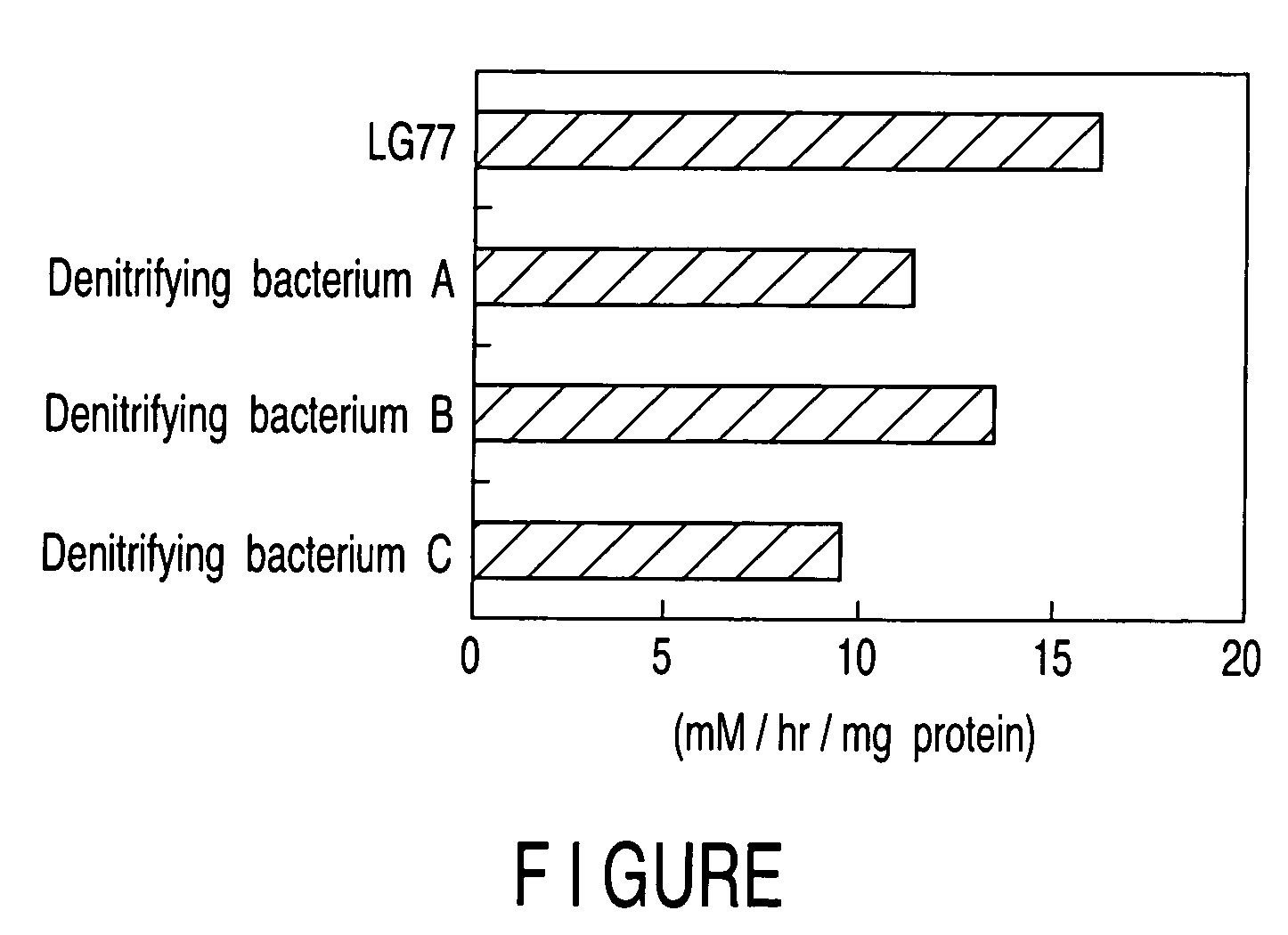Method of reducing nitrite and/or nitrosamine in tobacco leaves using microorganism having denitrifying ability
a technology of denitrifying ability and tobacco leaves, which is applied in the field of reducing nitrite and/or nitrosamine in tobacco leaves using microorganisms having denitrifying ability, can solve the problems of insufficient change in the components contained in the leaves, inability to exhibit characteristic color, flavor and taste, and insufficient reduction of tsna content in tobacco leaves, so as to reduce the content of tsna in tobacco leaves, reduce nitrite, and reduce
- Summary
- Abstract
- Description
- Claims
- Application Information
AI Technical Summary
Benefits of technology
Problems solved by technology
Method used
Image
Examples
example 1
Isolation and Selection of the Denitrifying Bacteria
[0044]The microorganism was separated according to the following procedure from tobacco leaves grown in a tobacco field in Oyama-shi, Tochigi prefecture, Japan.
[0045]The leaves of Michinoku 1, which is Burley variety, were harvested, and the lamina portions of the harvested tobacco leaves were cut off as samples. The obtained samples were finely cut to 5 mm squares and approximately 10 g of the cut samples was put into a 300 mL Erlenmeyer flask. After that, 200 mL of 10 mM phosphate buffer (pH 7.0) was added thereto and the mixture was homogenized. The obtained suspension was used as a tobacco suspension for isolation of microorganisms.
[0046]The obtained tobacco suspension was diluted with the above phosphate buffer to a concentration proper for isolation of microorganisms (102 to 105 times dilution).
[0047]The diluted suspension was applied, by dropping 0.1 mL a time, on a YG agar plate medium (yeast extract 1.0 g; glucose 1.0 g; K...
example 2
Identification of the Denitrifying Microorganism
[0060]The bacteriological characteristics of the microorganism LG77 having the highest denitrifying ability that was selected in Example 1 are shown in Table 1.
[0061]
TABLE 1Tested itemsLG 77ShapeRodGram stain−Spore−Motility+Behavior toward oxygenAerobicOxidase+Catalase+OFOColor tone of colonyNPProduction of fluorochromeNTReduction of nitrate+Production of indole−Fermentation of glucose−Arginine dihydrolase−Urease−Degradation of esculin+Liquefiability of gelatin−β-galactosidase+UtilizationGlucose+L-arabinose+D-mannose+D-mannitol+N-acetyl-D-glucosamine−Maltose+Potassium gluconate−n-capric acid−Adipic acid−dl-malic acid+Sodium citrate−Phenyl acetate−Sorbitol+Growth on MacConkey agar+Production of insoluble−yellow pigmentHydrolysis of Tween 80−Indentification resultAgrobacterium*Identification result by Japan Food Research LaboratoriesNP: Characteristic colony pigment was not producedNT: Not tested
[0062]From the results shown in Table 1, t...
example 3
The Effect of the Treatment During Curing Process on Suppression of TSNA Formation in Tobacco Leaves
[0065]The LG77 stain was inoculated in the 1 / 10 TS culture medium described in Example 2 and cultured at 30° C. for 72 hours. After the culture, the culture medium containing the bacterial cells was subjected to centrifugation at 5,000 rpm to collect the bacterial cells.
[0066]The obtained bacterial cells were washed twice with sterilized distilled water and then suspended again in sterilized distilled water. The concentration of the microorganism in the suspension was adjusted to be 108 to 1010 cfu / mL with distilled water.
[0067]Tobacco leaves of Burley variety (Kitakami 1) which had been harvested to be brought into the curing process were treated with the above-mentioned microbial suspension.
[0068]The treatment was carried out three times, i.e., immediately after the harvest, 3 days after the harvest, and 8 days after the harvest. In each treatment, the suspension was sprayed on the ...
PUM
 Login to View More
Login to View More Abstract
Description
Claims
Application Information
 Login to View More
Login to View More - R&D
- Intellectual Property
- Life Sciences
- Materials
- Tech Scout
- Unparalleled Data Quality
- Higher Quality Content
- 60% Fewer Hallucinations
Browse by: Latest US Patents, China's latest patents, Technical Efficacy Thesaurus, Application Domain, Technology Topic, Popular Technical Reports.
© 2025 PatSnap. All rights reserved.Legal|Privacy policy|Modern Slavery Act Transparency Statement|Sitemap|About US| Contact US: help@patsnap.com

